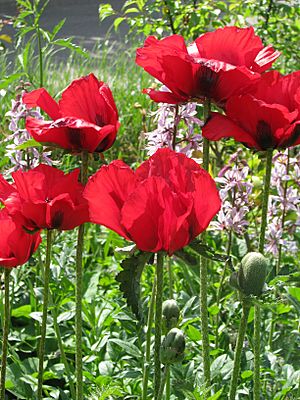Iranian poppy facts for kids
Quick facts for kids Iranian poppy |
|
|---|---|
 |
|
| Scientific classification | |
| Genus: |
Papaver
|
| Species: |
bracteatum
|
Papaver bracteatum, often called the Iranian poppy or Persian poppy, is a strong and beautiful type of poppy flower. It is also known as the great scarlet poppy because of its large, deep red flowers. These flowers can grow up to 8 inches (20 cm) wide and have a clear black spot near the bottom of their petals. The plant itself can grow quite tall, reaching up to 4 feet (1.22 meters) high on stiff stalks.
This poppy is very similar to the more commonly grown oriental poppy, Papaver orientale. Sometimes, people even consider it a special type of Papaver orientale.
What is the Iranian Poppy?
The Iranian poppy is a perennial plant, which means it lives for more than two years and comes back each growing season. It was first described by Dr. N. Saharghi and Iraj Lalezari in the scientific journal Nature in 1967. Its striking deep red color and prominent black spots make it stand out in gardens.
How is it Used?
The Iranian poppy is grown for its special properties. It contains substances that are used to make important medicines. These medicines help to relieve pain. This makes the plant valuable for medical purposes.
Poppies in Gardens
Many types of oriental poppies, including Papaver orientale and Papaver bracteatum, are popular in gardens. There are more than 80 different kinds of these poppies that have been created by cross-breeding. They are widely used in gardens across Europe, the United States, and other parts of the world.
One specific type, Papaver orientale 'Beauty of Livermere', looks very much like the wild P. bracteatum. Some people think it might even be a direct descendant or a hybrid that largely comes from P. bracteatum. This variety is also sometimes called P. orientale 'Goliath Group'. These beautiful poppies add a splash of color to many ornamental gardens.
See also
 In Spanish: Papaver bracteatum para niños
In Spanish: Papaver bracteatum para niños

